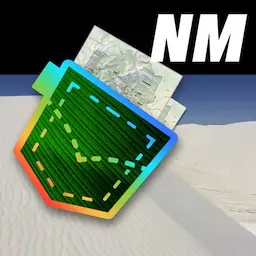"Cloudy afternoon sky at Aztec Ruins" by U.S. National Park Service , public domain
Resources Near and FarAztec Ruins |
featured in
| National Parks Pocket Maps |  | |
| New Mexico Pocket Maps |  |
Aztec Ruins
National Park Service
U.S. Department of the Interior
National Monument
Resources Near and Far
Trade
What was available
locally ?
The people of Aztec Ruins skillfully utilized the raw materials and resources
they found in their environment to make tools, process food, fabricate clothing,
create art and build their structures. They traveled long distances and maintained
extensive trade networks to obtain resources that were not locally available
to them. As you tour the ruins today, think about our society today and how
incredibly dependent we are on trade networks. What plants and animals do you
use around your house? What do you need to travel to the store to obtain? What
do you have to order from far away?
Bighorn sheep, deer, elk, bears, rodents, turkeys
and various other bird species were found in
this area and used for a multitude of purposes.
Bones were fashioned into awls, scrapers, beads,
whistles, needles and gaming pieces, while
feathers and hides were used to make warm
blankets, robes, and footwear. Sinew (tendon)
was wrapped around the end of reed arrows and
knives to prevent splitting.
Limestone, siltstone and sandstone were locally
available. They quarried stones from outcrops
and collected stones from river bottoms and
shaped them into tools such as hammer stones,
mauls, axes, manos, and metates. They used
stone tools to shape rock for constructing their
buildings. Prehistoric mauls and hammers were
found here and at sandstone quarries three to five
miles from Aztec Ruins.
Juniper, piñon pine, and cottonwood trees were
used for a variety of things. For example, juniper
was used as fuel and construction materials,
piñon pitch was used to waterproof baskets.
What could they obtain
nearby
The people of Aztec Ruins obtained obsidian
(volcanic glass) from the Jemez Mountain area,
about 85 miles southwest of here. They chipped
the obsidian into projectile points and sharp cutting tools such as knives, scrapers and blades.
The ancestral Pueblos also traveled 125 miles, to
an area just south of Santa Fe, to collect turquoise.
Turquoise was used to make jewelry such as pendants, ear ornaments, beads bracelets and other
body ornaments. Ponderosa pine, Douglas fir, and
aspen were hauled by foot more than 40 miles
from the San Juan Mountains to build the site.
Local native shrubs and plants such as yucca,
greasewood, sage, four-wing saltbrush, willows
and rushes were used. Yucca fibers were used as
cordage while yucca leaves were woven to make
sandals and paintbrushes and the ends used as
needles. Rushes and willow branches were used to
construct arrows.
Hematite, selenite, and crystalized gypsum were
collected locally. Hematite was used to make hammers, cylindrical paint sticks, pigments and beads
while flakes of selenite and gypsum were
fashioned into pendants.
What did they trade for?
What did they have to
trade?
The ancestral Pueblos had extensive trade networks extending to northern Mexico and the Gulf
of California. Three skulls, a skeleton and one
feather of a macaw from Mexico (still retaining its
blue and red colors) were found. These colorful
feathers were valued for their beauty and rarity
and used in ceremonies. Copper objects such as
bells and beads were also found here having been
traded from Mexico.
Shells were traded from the Gulf of Mexico and
used to make jewelry. Shells of at least nine
different species were found here. Walnut shells
were used as beads and charms. Walnut trees are
not native to this region, but do grow in
southwestern New Mexico and Arizona.
Twisted and braided cotton cord as well as cotton
cloth found in the site were likely obtained from
southern Arizona and Utah.
As mentioned, the Pueblos here at Aztec aquired
needed or desired objects such as salt, cotton,
shells, or macaw feathers. What did they trade in
return for these objects?
Aztec Ruins lies within a stones throw of the
Animas River and close to the confluence of three
rivers, enabling access to numerous water sources
and relatively fertile land. With the addition of
hand-dug irrigation canals, it became an
excellent area for farming. Corn, squash, and
beans were grown and traded to others for goods
not available locally.
Extensive trade networks
Just as our modern society maintains extensive trade networks
within our own country and
around the world, the ancestral
Pueblos here at Aztec utilized
resources near and far. The diagram
to the left shows areas where they
obtained certain goods illustrating
the extent to which the Pueblos
interacted and traded with people
within the Four Corners area and
1. Salt (approx. 300 miles away)
2. Shells (approx. 500 miles away)
3. Cotton (approx. 250 miles away)
4. Macaws (from northern Mexico)
5. Copper bells (from northern Mexico)
6. Turquoise (approx. 125 miles away)
7. Obsidian (approx. 85 miles away)
8. Lumber for construction (approx. 40 miles away)
9. Materials locally available: corn, yucca, deer, juniper, piñon, turkey, stones, etc.
EXPERIENCE YOUR AMERICA
Salt was highly valued for its use as a
preservative. Similar to modern-day Pueblos, the
people at Aztec likely made pilgrimages to gather
salt at salt flats near the present-day Zuni Pueblo
or western Arizona.
Clay was also more readily available in this area.
Consequently, elaborately decorated pottery was
manufactured here and traded to outsiders.


